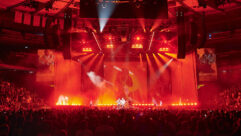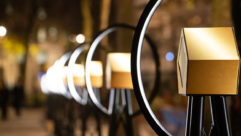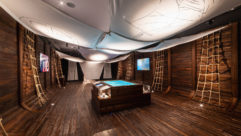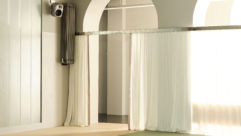Journey through acoustics
Dec 1, 1997 12:00 PM,
Ted Uzzle
John W. Kopec, The Sabines of Riverbank, Their Role in the Science ofArchitectural Acoustics, Acoustical Society of America, 1997, xvi + 212,cloth.
It’s like a yarn from Jules Verne.
A diletante with vast inherited wealth (well husbanded and enlarged)creates an estate along the Fox River near Geneva, IL. He falls under thespell of a believer that Francis Bacon wrote the works we attribute toShakespeare. She believes the plays and sonnets are filled with codedmessages that prove Bacon’s authorship and reveal his startling, butheretofore hidden, achievements in alchemy. The wealthy diletante hires astaff of codebreakers to assist the effort, and this staff is later hiredby the military to break enemy codes in the Great War of 1914-1918.
One discovery revealed by the code, previously known only to theRosicrucians, is an acoustical levitating machine. A huge drum with pianostrings stretched along its surface is rotated within an outer casing withcorresponding strings. As the strings vibrate, the outer shell is made tolevitate. So goes the theory; trouble is, it doesn’t work. The diletanteuses the occasion of a large family gift to a great university to invite afamous professor to his estate to study the problem. The professor takesone look, makes a few calculations, and convinces the diletante there willnever be enough sound energy to lift anything. Might the old gentleman beinterested in underwriting some genuine scientific research?
So began a decades-long voyage of discovery: The wonders recorded includedsound absorbers that seemed to absorb more sound than fell upon them; anacoustical consultant, never hired for a certain concert hall project, whowas criticized for its poor acoustics (while another acoustical consultantwas praised for the excellent acoustics of the very same hall); thestandard color of sound used in an acoustical laboratory; the requiredheight, weight and shoes for a lady floor-walker; and much, much more,equally exotic.
Our Captain Nemo was of course Colonel George Fabyan. Professor Aronnax wasplayed by Professor Wallace Clement Sabine (and after his death by hiscousin Paul Sabine, and even later by Paul Sabine’s son Hale Sabine). NedLand appears in this story, his real name Jack Wilhemson, a Norwegiansailor in charge of the Colonel’s fleet of boats and canoes on the FoxRiver. There’s even a giant squid, the manufacturers of acousticalmaterials, who want their products tested in common in a standard way, butwith enough individual exceptions to make the measurements incomparable.Instead of aboard the submarine Nautilus, these events took place atRiverbank, now part of Geneva, IL. And it all really happened.
It is hard to imagine a more colorful character than George Fabyan.Certainly Verne never created one. Born into a wealthy family of Bostoncotton merchants, he ran away at 16 and drifted around the midwest. At 26he took a job under an assumed name at the Fabyan cotton warehouse inChicago. Found out when his father visited the place, he was put in charge,and began buying land around Geneva township, eventually amassing 600 acres(2.4 kilometer squared).
Eventually devoting his full time to activities at his estate, calledRiverbank, he was an imposing figure, lordly of manner and with a cigarconstantly lit. He affected a white sweater, white trousers, white shoesand a blue blazer (except when he wore jodhpurs and knee-high ridingboots). He bred cattle, developed hybrid strains of various crops (everyoneat Riverbank ate bread from a new hybrid flour ground in the windmill onthe estate), conducted weapons research in trenches and battlements (forwhich the governor of Illinois made him an honorary colonel, a titleperfectly suited to his appalling vanity), supported cryptological analysisof the works of Bacon and Shakespeare, hosted such visitors as AlbertEinstein, Ernest Lawrence, Arthur Compton, P.T. Barnum (oh, to haveoverheard that conversation), and, famously, Wallace Clement Sabine. Thismenagerie of visitors was no more exotic than the animals and birds theColonel collected. Did I mention Frank Lloyd Wright designed the main houseat Riverbank? There was a Japanese garden squirreled away somewhere.
The catalog of astonishing phantasms could go on forever. Shall I tell youone more? Colonel Fabyan tried to close the segment of the navigable FoxRiver where it wound through his estate. The State of Illinois declined torepeal riparian law, even for the Colonel, so he constructed a lighthouseat the shore that flashed twice, then three times, then twice, then threetimes, and so on. Think of this as the Colonel elevating a finger towardthose navigating his stretch of the river, and calling out, “23 skidoo!”
In 1913 Wallace Sabine was just beginning to return to his work onacoustics. He had spent the decade ending in 1904 in a punishing routine ofteaching all day and conducting reverberation measurements all night,hundreds and hundreds per night. The opening of Symphony Hall in Bostonshould have been the crowning achievement of these arduous 10 years, butwhen it opened its acoustics received mixed, and generally negative,reviews. At a much more technical level, the reverberation time Sabinemeasured in the finished hall was somewhat shorter than he had predicted.Sabine began to let his acoustical researches slow down, and he busiedhimself with the minutia of his new deanship at Harvard. A decade afterthis an acoustical-materials manufacturing firm attempted to patentSabine’s reverberation formula, and he was tempted to return to acoustics.
Did Sabine have to be persuaded to visit Colonel Fabyan in 1913 and fix uphis anti-gravity machine? Perhaps, but by 1915 Fabyan had invited Sabine todesign a purpose-built acoustical laboratory on the Riverbank estate and beits director. The plans arrived at Riverbank in 1916, but the acousticallaboratory was not built until 1918. By then both Fabyan and Sabine wereworking full-time on war research. Sabine would be made a colonel in theAmerican, British, French and Italian armies (rather trumping ColonelFabyan’s Illinois colonelship), but he would also neglect his cancer,contract influenza, and die less than two months after the armistice.
Here was Colonel Fabyan, with the world’s first, and only, acousticallaboratory, and no one to run it. Hastily contacting relatives back inBoston, he learned of Paul Earls Sabine, a cousin of Wallace’s, but ratheryounger. Paul Sabine had just taken a Ph.D. from Harvard and conducted warwork, and planned to take up a post at what was then the Case School ofApplied Science in Cleveland. Could a deal be struck? A month after WallaceSabine died, Paul Sabine was ringing the doorbell at the Wallace ClementSabine Laboratory of Acoustics at Riverbank.
In the entranceway to the laboratory office was a bell with a pull-wirehanging from underneath it. On the wall next to the bell was a sign, “Ringbell for service.” Anyone unfortunate enough to pull the wire discoveredthe bell would drop and dangle and bang against the wall, raising the mostastonishing clatter that went on forever. If that didn’t frighten away thevisitor, a secretary would appear and direct visitors to the Colonel “inthe rear office.” Going through a door, the visitor found himself in anempty room with three further doors, one leading to a staircase and theothers to closets. In the back of one closet was a vault door, and the mostcourageous visitors, opening the vault door, would find the Colonel inside,sitting at a desk too large to have come in through the door. In fact, thewalls were built around the desk. Thus would the Colonel set the stage forhis discovery by visitors. Paul Sabine must have thought himself in amadhouse.
Colonel Fabyan pretended the great crash of 1929 didn’t happen, but wasstill obliged to reduce the staff at Riverbank and ask Paul Sabine to findways to make the acoustical laboratories pay for themselves. This task heaccepted with alacrity, and Paul Sabine turned a research institution intothe model on which acoustical testing laboratories would follow to thisday. Manufacturers were invited to send samples of materials or equipmentfor more sophisticated tests than they were able to do themselves. Also,Riverbank Labs offered independent testing backed by a reputation forhonesty. Paul Sabine was instrumental in setting up a trade association ofmanufacturers of acoustical materials, as well as the Acoustical Society ofAmerica, of which he was on the first slate of elected officers. PaulSabine was a pioneer in the development and use of electronic instrumentsfor acoustical measurements (when he arrived in February 1919 thelaboratory had nothing but stopwatches, tuning forks and organ pipes).Wallace Sabine may have turned architectural acoustics into a science, butPaul Sabine turned it into an industry.
In 1936 the Colonel died, and his widow died a few years later. Paul Sabineretired from the laboratories in 1947. Except for the semiconductor and thecomputer, architectural acoustics was as we know it today. Almostimmediately the Riverbank Acoustical Laboratories would begin majorchanges, however. Its operation was taken over by the Armour Institute ofTechnology’s Armour Research Foundation, which eventually became the ITTResearch Institute of the Illinois Institute of Technology.
After 26 years at the Celotex Corporation, Hale Sabine, Paul Sabine’s sonand the third of the Harvard-educated Sabine acousticians, accepted aposition at the Armour Research Foundation, and this brought him back toRiverbank in 1957, leaving in 1961 to manage the Owens-Corning acousticallaboratory.
In 1976 a Riverbank employee named John Kopec discovered Wallace ClementSabine’s research notebooks, and two years later found his files onconsulting projects. Kopec decided to assemble a history of Riverbank andof the Sabines, securing the assistance of Hale Sabine, the last livingRiverbank Sabine. After 20 years of arduous and serendipitous research, theAcoustical Society has published his book The Sabines at Riverbank, assatisfying a human story as a reader could hope for. This is the best kindof history, the kind concerned less with reviewing outcomes thanunderstanding processes. Although it may be true that some industries andsciences are created by great, impersonal forces, much of the appeal ofacoustics is its individualistic, picaresque history, characters largerthan life engaged obsessively in enterprises cautious people wouldn’ttouch. Even if you know or care nothing of architectural acoustics, thisobviously true story, too fantastic for fiction, is impossible to put down.For information about buying this book, circle (@@@) on the Rapid Factscard.










